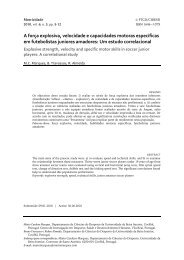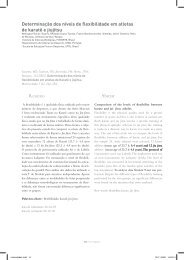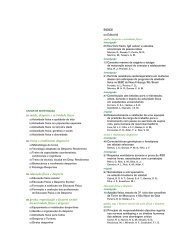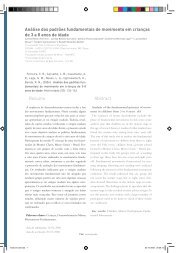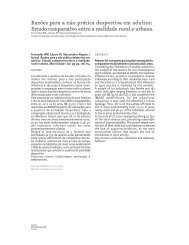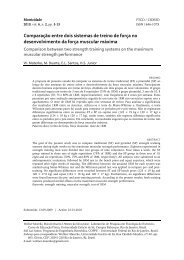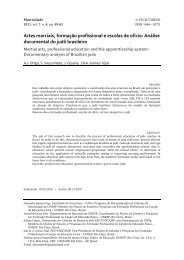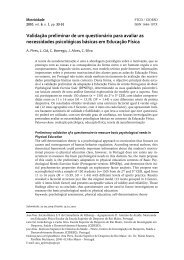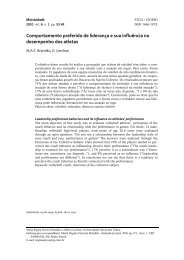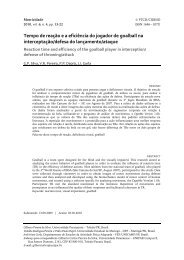revista motricidade
revista motricidade
revista motricidade
- No tags were found...
You also want an ePaper? Increase the reach of your titles
YUMPU automatically turns print PDFs into web optimized ePapers that Google loves.
Motricidade<br />
© FTCD/FIP-MOC<br />
2012, vol. 8, n. S1, pp. 73-79 Suplemento do 2º SIPD/CIDESD<br />
The latent order of complexity in team ball sports<br />
D. Araújo 1,2<br />
1 - Faculty of Human Kinetics, Technical University of Lisbon, Portugal<br />
2 - CIPER (Interdisciplinary Centre for the Study of Human Performance), Lisbon, Portugal<br />
In this work we addressed the definition of complexity in team ball sports, as well as ways to explain<br />
how the players cope with this complexity (but don't have to control it), by expressing order states<br />
congruent with goal achievement. Complexity is defined as the quantity of information that is needed<br />
to describe a system. However, there is a latent simplicity in the complexity of each phenomenon. This<br />
complexity is probably more a reflection of “boundary conditions” of our understanding, than the<br />
phenomena themselves. Complexity seems to be a surrogate for processes, ideas, structures, etc. But<br />
strictly speaking, if one looks at the smaller pieces, they are often quite simple. This is evident in the<br />
construction of a world championship, a team, human neural connections, cellular metabolism, etc. –<br />
it’s a matter of scale. If one looks at a team, it becomes immediately apparent that from a purely<br />
structural perspective, it is very simple: players compose it. The difficulty is that they are connected in<br />
a variety of ways. And, moreover, they are communicating to each other very often simultaneously.<br />
But, again, the communication itself is simple – if one knows the “language”. Therefore the complexity<br />
is tied to the interconnections. Knowledge of the interconnections is necessary to understand the<br />
whole phenomenon. The role of the sport scientist is to objectively capture this interconnectedness in<br />
the same (simple!) way expert players and coaches do. Several examples on team ball sports will be<br />
presented.<br />
Keywords: complexity, collective behavior, sport<br />
A review of performance analysis in Volleyball<br />
I. Mesquita 1,2<br />
1 - Centre of Research, Education, Innovation and Intervention in Sport<br />
2 - University of Porto, Sport Faculty, Portugal<br />
Performance analysis in Volleyball has been based on identifying potentially important game actions<br />
from a large number of studies ranging from the purely descriptive to those that have utilized<br />
correlational analyses. However, more recent research suggests that game performance occurs under<br />
dynamical and interactive conditions that are both time and context dependent. Consequently,<br />
analyzing the relationships among and between variables could be more useful to understanding the<br />
issues in question than the study of frequencies of behaviors. Such a belief supports the need for an<br />
ecological notational analysis, one that considers the match as a complex dynamic system. Due to the<br />
probabilistic nature of systemic processes, a promising approach to understanding the game may rely<br />
in establishing whether a state of the system augments or impairs the probability of a certain future<br />
state occurring. This historical feature points towards the importance of knowing the context of<br />
emergence of certain behaviors. Research has been moving in this direction, scrutinizing the<br />
sequentially of the events and their time course as well as the context of their emergence. Therefore,<br />
an analysis of probabilistic relationships between game actions that might predict certain outcomes, as<br />
well as taking into account situational variables (such as, the effects of quality of opposition and match<br />
status) has increasingly taken centre research stage. Preliminary findings from such work demonstrate<br />
a high functional dependence of technical and tactical actions throughout the game flow where, and in<br />
some extent, the quality of opposition and match status determine the game performance.<br />
Keywords: notational analysis, volleyball, dynamic approach, situational variables



